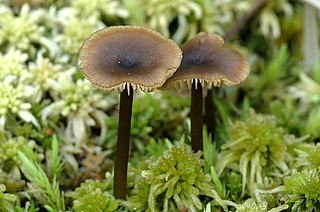
Apodemia is a New World genus of metalmark butterflies found from Canada to Brazil.

Apodemia mormo is a principally Nearctic butterfly in the family Riodinidae. It is a particularly fascinating species for ecological and evolutionary research, as evidenced by its shifting taxonomic classifications. Conflicting observations of host plants utilized, distinctive morphologies, and a wide range of occupied habitats have prompted investigation into several potential subspecies. To date, two genetic studies have been done on A. mormo, with analysis revealing that disjunct populations are genetically and phenotypically distinct. These studies support a potential need for refined taxonomies, although a larger body of data is required to make clear decisions.

The Siamese algae-eater is a species of freshwater fish in the carp family, Cyprinidae. This bottom-dwelling tropical fish is found in mainland Southeast Asia, including the Chao Phraya and Mekong basins as well as the Malay Peninsula. Its natural habitats are streams and rivers as well as flooded forests during the rainy season. The Siamese algae-eater should not be confused with the flying fox or the false siamensis , lacking the distinctive black bands of the former.
Bokermannohyla langei is a species of frog in the family Hylidae. It is endemic to Brazil, known only from Paraná. It is known from three specimens collected in 1953 and searches since 1986 have not found this frog. Its natural habitats are subtropical or tropical moist lowland forests, rivers, freshwater marshes, and intermittent freshwater marshes. It may be threatened by touristic activities but is protected by Parque Estadual Pico do Marumbi.

Apodemia mormo langei, the Lange's metalmark butterfly, is an endangered North American butterfly. It is a subspecies of the Mormon metalmark and belongs to the family Riodinidae. The butterfly is endemic to California, where it is known from one strip of riverbank in the San Francisco Bay Area. A 2008 count estimated the total remaining population at 131 individuals. Since 2011, this number has dropped to about 25–30.
The Amblyseiinae are a subfamily of mites in the Phytoseiidae family.
Kampimodromus is a genus of mites in the Phytoseiidae family.
Kampimodromus aberrans is a species of mite in the family Phytoseiidae. It is found in Europe.
Kampimodromus adrianae is a species of mite in the family Phytoseiidae.
Kampimodromus alettae is a species of mite in the family Phytoseiidae.
Kampimodromus echii is a species of mite in the family Phytoseiidae.
Kampimodromus ericinus is a species of mite in the family Phytoseiidae.
Kampimodromus hmiminai is a species of mite in the family Phytoseiidae.
Kampimodromus keae is a species of mite in the family Phytoseiidae.
Kampimodromus ragusai is a species of mite in the family Phytoseiidae.

Tephrocybe is a genus of about 40 species of mushroom, with a widespread distribution in temperate areas. The genus was circumscribed by Dutch mycologist Marinus Anton Donk in 1962.

Agaricus langei is a species of fungus in the genus Agaricus.

Crossocheilus, also known as the "algae eaters", is a genus of fish in the family Cyprinidae. It is distributed in China, India, Indonesia, Malaysia and Thailand in Asia. These fish occur in several types of habitat, often fast-flowing rivers with rocky bottoms.

Crossocheilus langei, also known as the red algae eater, is a species of ray-finned fish in the genus Crossocheilus. It is native to Malaysia and Sumatra. This bottom-dwelling tropical fish is found in mainland Southeast Asia. Its natural habitats are streams and rivers as well as flooded forests during the rainy season. It is often confused with the Crossocheilus oblongus, however, both are algae eaters and will behave similarly.
Philotheca langei is a species of flowering plant in the family Rutaceae and is endemic to a restricted area of the south-west of Western Australia. It is a small shrub with club-shaped, glandular-warty leaves and white flowers arranged singly or in twos or threes on the ends of branchlets.






